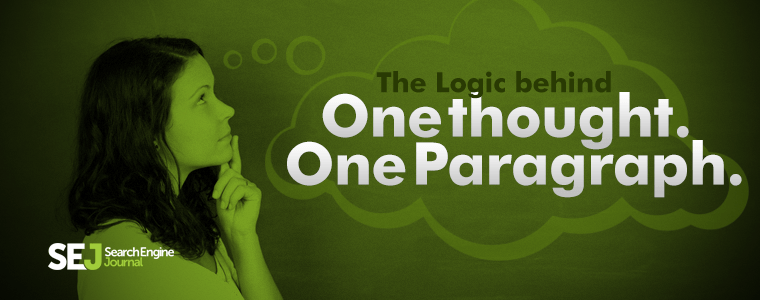I read a lot of content every day, but regardless who the author is or the topic, there is one thing that always results in me either bookmarking the article for later, or just closing it and moving on – long and intimidating paragraphs.
I, like many others, have a lot on my plate, very little time in the day, and hundreds of articles to skim through every week. So when I see excessively long paragraphs, it intimidates me and makes me feel like I don’t have enough time (or energy) to read the whole article.
Because of this, I have always recommended, whether to a client or as a speaker, that writers break paragraphs whenever possible, so readers are less intimidated and able to skim content easier.
While preparing for my presentation on Creating Blockbuster Content for SMX Advanced last year, I found myself again adding this concept to my slides and decided I wanted to know a bit more about this concept of One Thought, One Paragraph.
Why, Why, Why?
- Does the brain read better this way?
- Are we able to absorb more information with shorter paragraphs?
- Is this the trick to keeping someone’s interest?
I started digging into the core reason behind the writing standard of one thought paragraphs. I found there was more to it than I realized – there was a science behind the writing.
It seems that writers, researchers, colleges, governments, and well… every writing expert, supports the “one thought, one paragraph” rule. Keep each paragraph you write limited to one thought.
If you read for pleasure, grab a novel. If you read for action, One Thought, One Paragraph divides the message into bites that are more easily tasted, more digestible, and more immediately actionable. ~ Peter Killeen, Professor of Psychology at ASU
Although it makes sense on the surface, there is scientific proof to back up this core rule of writing.

Simplicity is Ingrained in Our Brains
At one time, before sentence structures and paragraphs were a concern, humans had to fend for themselves. Survival required hunting and gathering food and left very little time or energy for anything else.
Our brains are programmed to find food, raise children and do little else, says one neuroscientist and author of “The Organized Mind,” Daniel Levitin.
As the world evolved, more distractions entered our daily lives. Now, keeping up on the flood of information is more challenging. Today’s society is more disorganized and chaotic than ever before. Forcing your reader to sift through complex topics in each of your paragraphs is unfair and unproductive.
Not to mention that as we get older, this effect can be compounded, as Karen Whiteman, PhD explains; “Theories of age-related decline suggest that older adults strain their short-term memory when they take on tasks with high attentional demands such as reading a complex paragraph with multiple thoughts. In this instance, it’s possible they may spend a disproportionate amount of time reading a complex paragraph and may not be able to accurately retrieve this information from memory.”
Multi-Tasking in Your Paragraphs
Cramming multiple thoughts into one paragraph is the equivalent of writing multi-tasking. It’s confusing and it clouds your reader’s ability to absorb the information you’re offering.
Multi-tasking, “…releases the stress hormone, cortisol, in the brain which leads to foggy thinking, so you’re not even able to judge well whether you’re working well or not,” Levitin says.
The goal of your writing is to give clarity about a particular subject to your audience. By weaving several thoughts together into one small chunk of text, you confuse your reader.
In addition to confusing your readers, you might also be contributing to ‘brain drain’ as Peter Killeen, PhD suggests. “Thinking requires enormous nutritional support—brain food in the form of lactate, created in neurons and astroglia. Focus on a topic for extended time (starting after 1 to 2 minutes and maxing around 10 minutes) depletes these resources. To the extent that tasks can be partitioned into modules, the brain can ‘catch its breath’ between modules.
It can engage action, such as relating the module’s content to personal goals. That diversity of action further alleviates the ‘brain drain’ of narrow focus.”
Writing for the Modern Day Reader
Much of today’s reading happens on the screen. E-readers, tablets, smartphones, and computers have changed the way we absorb information.
Lab experiments show that reading on the screen changes the way people absorb information than when reading text on a paper.
Navigating long text is less intuitive. With that in mind, it’s not surprising that scientists found readers find consuming information on a screen less satisfying too.
That could be because our brains perceive chunks of text as a type of physical landscape.
The structure of a sentence, paragraph, and article gives meaning to your writing.
In print, your reader can focus exclusively on one page or one section at a time. On the screen, your reader is distracted by dozens of other messages, such as commercials, suggested articles, images, videos, audio, and more.
Long paragraphs ask for large commitments; short ones are pay as you go, and compete effectively with alternative activities. ~ Peter Killeen, Professor of Psychology at ASU
To keep your reader’s focus, you must structure your text in a way that gives your audience a better experience.

Attitude Shifts
The attitude your readers have toward your text changes based on where it is consumed too.
People reading on screen take a lot of shortcuts, according to a study at San Jose State University. Instead of absorbing every detail in the text, readers look for keywords and short sentences to make consumption faster and easier.
When you write in shorter paragraphs you answer your reader’s needs by creating text that’s easy to navigate and easy to scan.
Alternative Thought
Clive Thompson, author of Smarter Than You Think: How Technology is Changing Our Minds for the Better and contributing author at Wired, New York Times, and the Washington Post, has a slightly different view and take on the One Paragraph, One Thought concept, which is quite interesting and possibly the only argument I have heard for longer paragraphs that I agree with:
“There are times when the idea or facts you’re trying to get across are complex and require focus and attention. In those situations, you might need the particular power of longer paragraphs — their ability to chain together several ideas in one sustained thought. There’s never any excuse for using needless jargon, but when you’re asking a reader to do serious intellectual work — and when you’re doing it yourself — longer paragraphs and more complicated sentences are natural and valuable tools.
And frankly, if you’re simply a really good writer, the audience you want in these cases — the people who are eager to follow a sophisticated argument or learn a *lot* of new things — will come along. I’ve been writing a bunch of essays for The Message, a group blog on Medium, and pieces of comparable length and complexity have completely different readerships. This piece on the “Joy of Typing” is 2,023 words long, and another piece — about a 1960s sci-fi YA novel perfectly predicted the rise of personal drone politics — nearly exactly the same length, 2,036 words. They have, to my eye, fairly similar levels of complexity in the language, paragraph length, and whatnot. But the one on typing had *20 times as many people who read it all the way through* compared to the one about the sci-fi novel, according to Medium’s metrics. Why? Clearly the former topic grabbed people’s attention in a way the second didn’t. Certainly the relative complexity and length of the articles couldn’t have been at issue; they were nearly similar.
So the length and complexity of one’s language matters — but only up to a point. Going longer doesn’t kill the audience if you’re being useful, interesting and informative!”
Practice This Rule
As you move away from this article and read through other pieces, keep this in mind: today’s top writers practice this rule for a reason.
The Economist’s style guide suggests, “long paragraphs, like long sentences, can confuse the reader.”
In Ann Handley’s book, “Everybody Writes” she says, “No one will ever complain that you’ve made things too simple to understand.” Limiting your paragraphs to one thought makes your thoughts easy to digest without dumbing down the content.
Science backs the notion that writing in shorter, one thought paragraphs works.
Put yourself in your reader’s position while writing. Will your text overwhelm your reader? Will it confuse his or her mind with non-intuitive navigation? Or will it allow your reader to easily scan for the nuggets of desired information?
*I would like to personally thank Karen Whiteman, Peter Killeen, and Clive Thompson for taking the time to contribute and discuss this topic with me.
Images created by SEJ






![[SEO, PPC & Attribution] Unlocking The Power Of Offline Marketing In A Digital World](https://www.searchenginejournal.com/wp-content/uploads/2025/03/sidebar1x-534.png)